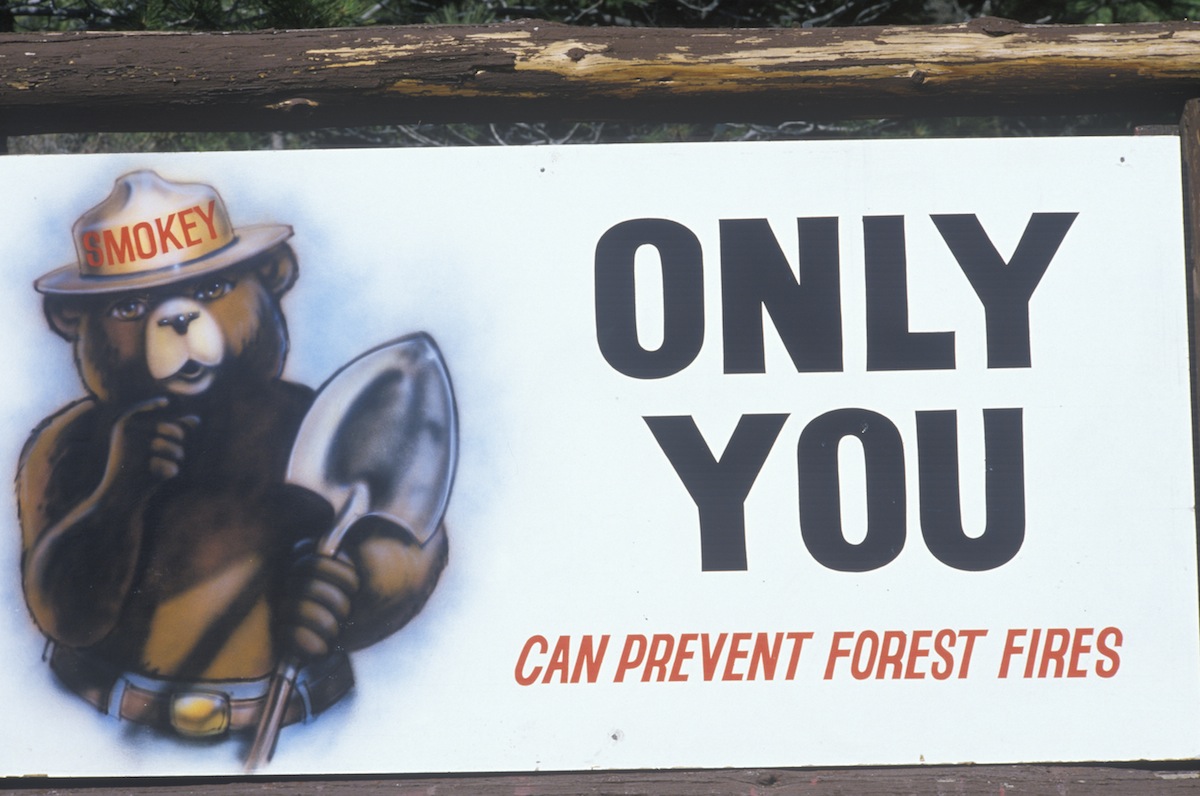

This post is in partnership with the History News Network, the website that puts the news into historical perspective. The article below was originally published at HNN.
What should we do with Smokey Bear? He is now 71 and showing his age. His message has long passed its shelf life. For 50 years frustrated critics of American fire policy have sought to eject him from the community and move the American way of fire from simple suppression to a more pluralistic management. One might as well chisel away at Mount Rushmore. Smokey’s old message needs to go but most of the public doesn’t want Smokey himself to leave, certainly not in shame.
He was created during World War II. The Wartime Advertising Council devised the country’s first national forest fire prevention program in 1942 amidst alarms of incendiary attacks from Japan and fifth column arsonists. When Disney Studios released Bambi, Bambi became the face of the program, targeting kids rather than Axis commandos. Then Disney refused to allow Bambi to act as front man. A committee created a cartoon alternative under a stringent set of guidelines. He would have “a short nose (Panda style), brown or black fur, with an appealing expression, a knowledgeable but quizzical look,” perhaps wearing a “campaign hat that typifies the outdoors.” He could not resemble cartoon bears used by the Boy Scouts, Piper Cub airplanes, or political cartoonists like Cliff Berryman to represent Russia, or even the bears on a popular Forest Service bookmark. In 1944 Albert Staehle gave those prescriptions an image.
Two years later Smokey got his radio voice; a year later, his tagline, “Remember… Only You Can Prevent Forest Fires”; and in 1948, his modern rendition from the pen of Forest Service artist, Rudy Wendelin. Smokey joined the baby boom.
They grew up together. Smokey became the Boomers’ wildland teddy bear. In 1950 an orphaned bear cub was found after a New Mexico fire and became Little Smokey as life imitated art. By now the country had entered a Cold War on fire, conflating the two red menaces. The Wartime Ad Council became the Ad Council but continued as Smokey’s promotional arm. In 1952 Congress passed the Smokey Bear Act to regulate the commercial use of Smokey. Little Smokey’s lair in the National Zoo acquired its own zip code. Smokey had a Saturday morning cartoon show. A 1968 survey identified Smokey Bear as the “most popular symbol” in American culture. The poet Gary Snyder even wrote a Smokey Bear sutra in which Smokey stands for the defense of the natural world against the toxins, wreckage, and general insults of modern society, armed with a shovel and his war cry. “Drown their butts. Crush their butts.”
Magic had happened, no one quite knew how, but they were sure they didn’t want to break the spell. Yet the fire community did know the message was not true — had never been true. In fact, by removing good fires as well as bad ones the fire establishment, led by the Forest Service, by now indelibly identified with Smokey Bear, the program had caused considerable ecological damage and was creating conditions that would become economically unsustainable as well. By the early 1960s critics campaigned to put good fire back into America’s wild and working landscapes. To the reformers Smokey morphed from a Santa Claus figure to a Darth Vader clone. Twenty years after Rudy Wendelin birthed him, critics despaired over Smokey. They attacked him. They mocked his message. They seemingly concluded that bad fire policy had happened because of malevolent advertising, and that removing the symbol would reform the message.
Meanwhile fire policy had been rechartered on the ambition to restore fire. When Little Smokey became decrepit in 1975 (dying two years later), instead of burying him with honors and moving on, the program found a new cub to take his place. The message continued. By then the National Park Service was nine years into the new policy and the Forest Service a year away from a wholesale reformation to accept it. There now exists a serious disconnect between the beast and his burden, between Smokey’s message and the nation’s fire policy. Critics continue to hack away at Smokey as the symbol of what is wrong — his notoriety assures them attention (so they believe) for their own counter-message. The fact is, attacking Smokey has gone nowhere. It has gone nowhere for decades. A long, big generation grew up with Smokey. They dismiss the mockers and besmirchers and activists. They like Smokey. Probably they are willing to have his message rewritten. They aren’t interested in trashing Smokey himself. In reality, the bear and his tagline parted long ago. Smokey stands for the benign woods and those who would protect them, and for many, a remembered childhood (interestingly he’s less well known to youth today). To most people, he’s a celebrity — known for being known, associated with fire protection, but not identified with any nuances in fire policy. He assures by just being there. He’s less a protector from fires than of childhood memory.
Still, he needs to go. But how do we gently nudge so emblematic an icon off the stage? We formally retire him. We give him a gold shovel and a hearty handshake and the thanks of a grateful nation for doing the job we asked of him. Then we let him trundle off to a cabin in the woods and let his two cubs, the next generation, take over.
The cubs have been in Smokey’s images for a long time. They appear by his side, he tells them about nature. Let them do the two jobs we need now: to fight fire and to light fire. Let a proud Smokey watch them take on the vexing fire scene of the future. Let him wax a bit nostalgic, maybe — “it was different in my day.” Let him retell his story to his grandcubs, his reading glasses at the tip of his nose, reaching to temples of graying fur, and wish the youngsters well. But move him from the National Zoo to the National Museum of American History. He deserves to be remembered as a lively part of the national culture. Let him live in the past in a place where the past itself lives. But let him leave.
Stephen J. Pyne is a historian in the School of Life Sciences, Arizona State University, and the author of the recently published Between Two Fires: A Fire History of Contemporary America.
More Must-Reads from TIME
- Donald Trump Is TIME's 2024 Person of the Year
- Why We Chose Trump as Person of the Year
- Is Intermittent Fasting Good or Bad for You?
- The 100 Must-Read Books of 2024
- The 20 Best Christmas TV Episodes
- Column: If Optimism Feels Ridiculous Now, Try Hope
- The Future of Climate Action Is Trade Policy
- Merle Bombardieri Is Helping People Make the Baby Decision
Contact us at letters@time.com